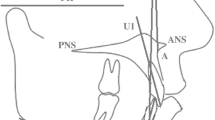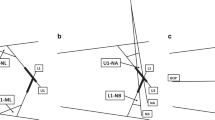Abstract
Objective
The aim of this study was to assess the relationship between dynamic measurements of natural head position (NHP) and lower incisor irregularity to identify potential gender differences.
Materials and methods
A total of 103 plaster models and dynamic NHP measurements were taken from 51 male (mean age: 14.20 ± 2.51 years) and 52 female (mean age: 15.02 ± 2.67 years) subjects. The dynamic NHP data were gathered by using an inclinometer device and a portable data logger. Lower incisor irregularity was measured with Little’s irregularity index. The Mann–Whitney U and Kruskal–Wallis rank tests were used at a significance level of p < 0.05. To evaluate the correlation between NHP and lower incisor irregularity, Spearman correlation coefficients (r) were calculated.
Results
There were significant gender differences in the sagittal measurements of NHP (p = 0.031) and incisor irregularity (p = 0.023). A Kruskal–Wallis test revealed no significant difference in NHP measurements between subjects presenting different levels of irregularity. Females displayed no significant correlation between incisor irregularity and any NHP measurement. However, in the males high correlation coefficients between incisor irregularity and sagittal NHP measurements (r = 0.369; p = 0.008) were noted.
Conclusion
Significant correlations between lower incisor irregularity and sagittal NHP measurements in males were observed. Females had a more forwardly inclined NHP than males. Moreover, male subjects displayed greater incisor irregularity than female subjects.
Zusammenfassung
Zielsetzung
Ziel der Studie war es, eine potenzielle Beziehung zwischen dynamischen Messungen der natürlichen Kopfhaltung (“natural head position”, NHP) und Irregularitäten bei den unteren Schneidezähnen zu untersuchen und ferner mögliche geschlechtsbezogene Unterschiede zu ermitteln.
Material und Methoden
Eingeschlossen in die Studie wurden insgesamt 103 Gipsmodelle sowie dynamische NHP-Messungen von 51 männlichen und 52 weiblichen (Durchschnittsalter 14,20 ± 2,51 bzw. 15,02 ± 2,67 Jahre) Probanden. Zur Erhebung der dynamischen NHP-Daten dienten ein Inklinometer und ein mobiler Datenlogger, zur Bestimmung der Frontzahnstellung der Irregularitätsindex nach Little. Zur statistischen Auswertung wurden der Mann–Whitney-U- und der Kruskal–Wallis-Rangtest bei einem Signifikanzniveau von p < 0,05 verwendet. Zur Evaluierung der Korrelation zwischen NHP und Frontzahnirregularität wurden die Spearman-Korrelationskoeffizienten (r) berechnet.
Ergebnisse
Es zeigten sich geschlechtsbezogene Unterschiede bei sagittalen NHP-Messungen (p = 0,031) und Frontzahnirregularität (p = 0,023). Im Kruskal–Wallis-Test ergaben sich keine signifikanten Unterschiede in den NHP-Messungen zwischen Probanden mit unterschiedlich ausgeprägten Irregularitäten. Bei weiblichen Probanden bestand keine signifikante Korrelation zwischen Schneidezahnirregularität und einer der NHP-Messungen, bei männlichen dagegen zeigten sich hohe Korrelationskoeffizienten zwischen Frontzahnirregularität und sagittalen NHP-Messungen (r = 0,369; p = 0,008).
Schlussfolgerung
Signifikante Korrelationen zwischen Frontzahnirregularität und sagittalen NHP-Messungen wurden bei den männlichen Probanden beobachtet. Die weiblichen Probanden hatten eine mehr nach vorn geneigte NHP als die männlichen. Darüber hinaus zeigten die männlichen Probanden eine ausgeprägtere Frontzahnirregularität als die weiblichen.


Similar content being viewed by others
References
Archer SY, Vig PS (1985) Effects of head position on intraoral pressures in Class I and Class II adults. Am J Orthod 87:311–318
Bernabé E, Villanueva KM, Flores-Mir C (2004) Tooth width ratios in crowded and noncrowded dentitions. Angle Orthod 74:765–768
Buschang PH, Shulman JD (2003) Incisor crowding in untreated persons 15–50 years of age: United States. Angle Orthod 73(5):502–508
Carmen RB (1978) A study of mandibular anterior crowding in untreated cases and its predictability, M.S. Thesis, Ohio State University
Cooke MS, Wei SH (1988) Intersex differences in craniocervical morphology and posture in southern Chinese and British Caucasians. Am J Phys Anthropol 77:43–51
Cuccia AM, Maurizio L, Caradonna D (2008) Oral breathing and head posture. Angle Orthod 78:77–82
Foster TD, Hamilton MC, Lavelle CL (1970) A study of dental arch crowding in four age-groups. Dent Pract Dent Rec 21:9–12
Gracco A, Malaguti A, Lombardo L, Mazzoli A, Raffaeli R (2010) Palatal volume following rapid maxillary expansion in mixed dentition. Angle Orthod 80:153–159
Harvold EP (1968) The role of function in the etiology and treatment of malocclusion. Am J Orthod 54:883–898
Hellsing E, Reigo T, McWilliam J, Spangfort E (1987) Cervical and lumbar lordosis and thoracic kyphosis in 8, 11 and 15-year-old children. Eur J Orthod 9:129–138
Huggare J, Harkness E (1993) Associations between head posture and dental occlusion. J Dent Res 72:255
Huggare J (1987) A roentgenocephalometric study of head posture and craniofacial morphogenesis in the cold environment of Northern Finland. Proc Finn Dent Soc 83(Suppl 2–3):1–75
Huggare JA, Laine-Alava MT (1997) Nasorespiratory function and head posture. Am J Orthod Dentofac Orthop 112:507–511
Johal AS, Battagel JM (1997) Dental crowding: a comparison of three methods of assessment. Eur J Orthod 19:543–551
Lauder R, Muhl ZF (1991) Estimation of tounge volume from magnetic resonance imaging. Angle Orthod 61:175–184
Leighton BC, Hunter WS (1982) Relationship between lower arch spacing/crowding and facial height and depth. Am J Orthod 82:418–425
Little RM (1975) The irregularity index: a quantitative score of mandibular anterior alignment. Am J Orthod 68:554–563
Marcotte MR (1981) Head posture and dentofacial proportions. Angle Orthod 51:208–213
Mitchell JI, Williamson FH (1978) A comparison of maximum perioral muscle forces in North American blacks and whites. Angle Orthod 48:126–131
Moorrees CFA (1995) Natural head position: the key to cephalometry. In: Jacobson A (ed) Radiographic cephalometry. Quintessence Publishing Co, Chicago, pp 175–184
Motoyoshi M, Shimazaki T, Sugai T, Namura S (2002) Biomechanical influences of head posture on occlusion: an experimental study using finite element analysis. Eur J Orthod 24:319–326
Murphy KE, Preston CB, Evans WG (1991) The development of instrumentation for the dynamic measurement of changing head posture. Am J Orthod Dentofac Orthop 99:520–526
Pachi FP, Turlà R, Checchi AP (2009) Head posture and lower arch dental crowding. Angle Orthod 79:873–879
Preston CB, Evans WG, Todres JI (1997) The relationship between ortho head posture and head posture measured during walking. Am J Orthod Dentofac Orthop 111:283–287
Rocabado M, Johnston BE, Blakney MG (1982) Physical therapy and dentistry: an overview. J Craniomandib Pract 1:46–49
Sayin MO, Türkkahraman H (2004) Factors contributing to mandibular anterior crowding in the early mixed dentition. Angle Orthod 74:754–758
Schwartz AM (1926) Kopfhaltung und Kiefer. Zeitschrift für Stomatologie 24:669–774
Sinclair PM, Little RM (1983) Maturation of untreated normal occlusions. Am J Orthod 83:114–123
Solow B, Greve E (1979) Craniocervical angulation and nasal respiratory resistance. In: McNamara J (ed) Naso-respiratory function and craniofacial growth, craniofacial growth series, monograph 9. Center of Human Growth and Development, University of Michigan, Ann Arbor, pp 87–119
Solow B, Sonnesen L (1998) Head posture and malocclusion. Eur J Orthod 20:685–693
Solow B, Tallgren A (1976) Head posture and craniofacial morphology. Am J Phys Anthropol 44:417–435
Southard TE, Behrents RG, Tolley EA (1990) The anterior component of occlusal force. Part 2. Relationship with dental malalignment. Am J Orthod Dentofacial Orthop 97:41–44
Tecco S, Festa F, Tete S, Longhi V, D’Attilio M (2005) Changes in head posture after rapid maxillary expansion in mouth-breathing girls: a controlled study. Angle Orthod 75:171–176
Thilander B, Pena L, Infante C, Parada SS, Mayorga C (2001) Prevalence of malocclusion and orthodontic treatment need in children and adolescents in Bogota, Colombia. An epidemiological study related to different stages of dental development. Eur J Orthod 23:153–167
Torassian G, Kau CH, English JD et al (2010) Digital models vs plaster models using alginate and alginate substitute materials. Angle Orthod 80:474–481
Turkkahraman H, Sayın MO (2004) Relationship between mandibular anterior crowding and lateral dentofacial morphology in the early mixed dentition. Angle Orthod 74(6):759–764
Usumez S, Orhan M (2003) Reproducibility of natural head position measured with an inclinometer. Am J Orthod Dentofac Orthop 123:451–454
Vig P, Showfety K, Phillips C (1980) Experimental manipulation of head posture. Am J Orthod 77:258–268
Acknowledgments
This study was supported by Erciyes University. The author would like to thank Gökmen Zararsız for statistical analysis.
Author information
Authors and Affiliations
Corresponding author
Ethics declarations
Conflict of interest
Tancan Uysal, Ahmet Yagci, Abdullah Ekizer, and Serdar Usumez state that there are no conflicts of interest.
All studies on humans described in the present manuscript were carried out with the approval of the responsible ethics committee and in accordance with national law and the Helsinki Declaration of 1975 (in its current, revised form). Informed consent was obtained from all patients included in studies.
Additional information
Prof. Dr. Tancan Uysal.
Rights and permissions
About this article
Cite this article
Uysal, T., Yagci, A., Ekizer, A. et al. Natural head position and lower incisor irregularity. J Orofac Orthop 77, 112–118 (2016). https://doi.org/10.1007/s00056-016-0015-7
Received:
Accepted:
Published:
Issue Date:
DOI: https://doi.org/10.1007/s00056-016-0015-7




